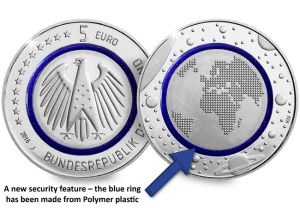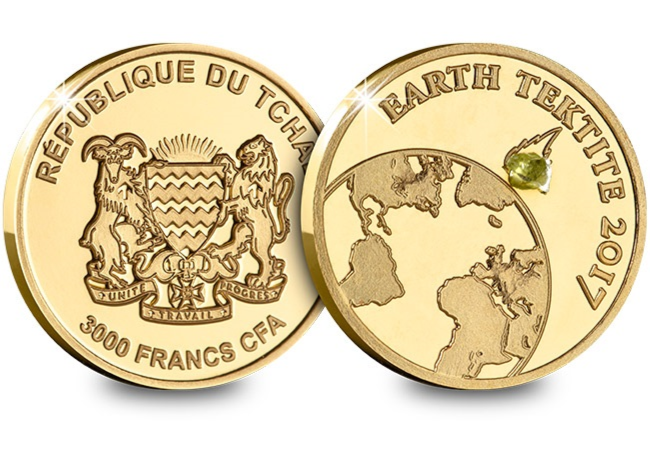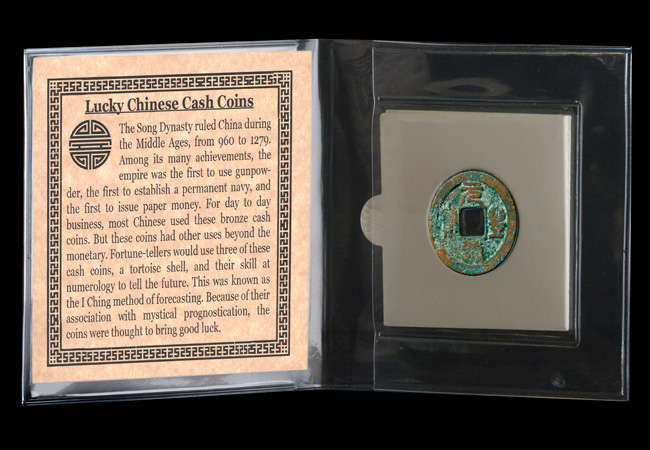Posts Tagged ‘Coins’
5 Fascinating Coins from Around the World
As today is Random Acts of Kindness day, I’ve decided to take a look and some of the most random, weird and wonderful coins issued from all around the world.
Whilst these coins haven’t entered circulation, I’m sure you will agree that they are works of art from truly innovative Mints. It’s been really exciting to discover the unique coins different countries have to offer, so take a look at the designs below to see some of the fascinating coins international mints have produced.
Germany’s see through 5 Euro

Developed by Dr Peter Huber and Günther Waadt, this unusual coin is a first of its kind. Released in 2016, the see through coin features a blue plastic ring in the middle and has been named ‘Blue Planet Earth’.
Not only is the blue ring easy to identify and authenticate by the naked eye, it is made of polymer plastic which behaves like a form of insulation between the pieces of two different metals and will be easy for cash machine to recognize whether it is real or fake.

German 5 euros. Credit: coincollectionmarket.com
A German Minting Technology team has spent a decade developing this new security feature. In fact, it’s the first coin to be made from a combination of metal and plastic materials which are rumoured to change colour when exposed to UV light.
In 2017, five more coins were created to reflect Earth’s climatic zones with the use of a different coloured plastic polymer ring to represent each zone. The series will continue releasing one coin per year until 2021.
Canada’s 3D Snowball Fight 50 Cents

Image credit: www.mint.ca
We all love a snowball fight and this wonderful Canadian 50 Cent coin allows you to bring to life the magic of a snowball fight on an innovative 3D coin!
The Royal Canadian Mint is renowned for their forward thinking technology, and in 2018 they used lenticular printing to create artist Tony Bianco’s fun-filled design with an illusion of depth, which actually appears to move as the coin is viewed from different angles – so watch out for those snowballs!
It really put a smile on my face when I came upon this coin in my research, and with a mintage of just 20,000 I’m sure those few Canadian Change Checkers who were lucky enough to add this coin to their collection will really treasure this coin.
Palau’s Bottle Top Coin

This is the world’s first ever ‘beer bottle top-shaped’ legal tender coin. Issued in 2016 to honour the 500th Anniversary of the Bavarian Purity Law – the enactment by Duke Wilhelm IV of Bavaria in 1516 states that only 4 ingredients can be used to produce the beer and even provides a restriction on pricing.
Whether you’re a beer lover or coin enthusiast – or both – I’m sure you’ll agree that this unusual coin is a fitting tribute to this landmark occasion in the history of brewing.
The obverse of the crown-cap-shaped coin shows the coat of arms of the issuing state below an outrigger canoe. Whilst the reverse shows two toasting beer mugs and a crown.
Nauru’s First Issue of the Euro 10 Dollars

Image credit: Numista
This unique and incredibly intricate ten dollar coin was issued in Nauru (a tiny island in Micronesia, northeast of Australia) in 2002 to commemorate the first Euro coinage.
The unusual coin is shaped as a map of Europe and has been struck in .999 pure silver.
On the obverse you can see the Bank of Nauru’s coat of arms and on the reverse is a gold plated Euro coin and the words ‘2002 – FIRST ISSUE OF THE EURO’.
Chad’s Earth Meteorite Gold Proof 3000 Francs

Within this Pure Gold Proof coin, issued in Chad in 2017, is a Moldavite Tektite gemstone – unique evidence of what can happen on the incredibly rare occasion that a meteorite hits the Earth.
These gemstones can only be found at five locations on Earth, and throughout the Middle Ages, they were highly prized and strictly reserved for those born of royal blood and nobility.
Struck from 0.5g of pure Gold, this coin is what is known as ‘small’ Gold – a collecting craze that is proving to be extremely popular among collectors worldwide, making this already very unique coin even more special.
With so many fascinating coins issued around the world, you don’t have to look far to find inspiration for your international collection. What do you think about the coins above and have you found any weird and wonderful coins for yourself?
The rarest 50p and £2 coins revealed! UPDATED UK mintage figures.
As collectors, we often find ourselves focusing on the commemorative coins that turn up in our change, but how often do we pay attention to the definitive designs?
We wouldn’t normally combine definitive and commemorative mintage figures into one chart, however the comparative figures give us an interesting insight into the change in our pockets and actually go to show why the definitive coin designs deserve your attention…
50p Mintage Figures
Our latest charts featuring the updated commemorative coin mintage figures for circulation coins revealed the 2017 Sir Isaac Newton 50p as the second rarest UK 50p in circulation after the Kew Gardens, with a mintage of just 1,801,500. This knocked Jemima Puddle Duck off the second spot with a whopping 298,500 less coins being struck.
Change Checkers had already shown a great response to the Sir Isaac Newton coin, voting it their favourite coin design of the year in 2017. But now, as we delve deeper into the mintage figures for not only commemorative 50p coins but also the definitive designs, an unlikely rival has pipped the 2017 Isaac Newton to the post to claim the title of the second rarest UK 50p coin in circulation…

You might be surprised by the second rarest 50p in circulation…
The chart above features the mintage figures for every commemorative and definitive UK 50p coin in circulation and whilst the Kew Gardens still remains king, it came as a surprise that the second rarest 50p was actually a definitive rather than a commemorative design.
The 2017 Royal Shield 50p has a mintage of just 1,800,000 which means there are 1,500 less coins than the 2017 Sir Isaac Newton 50p. This is by far the lowest mintage figure for any definitive 50p coin, with the next rarest definitive coin having almost double the amount of coins struck – the 2008 Britannia with a mintage of 3,500,000.
Definitive 50p coin designs
Christopher Ironside’s Britannia design featured on all UK definitive coins from their first appearance in 1969 with the words ‘NEW PENCE’ inscribed above. The inscription was revised in 1982 to say ‘FIFTY PENCE’ and this design remained unchanged until 2008, when Matthew Dent’s Royal Shield design was introduced, featuring the third and fourth quarters of the Royal Arms.

It comes as no surprise that the majority of the definitive designs can be found towards the bottom of the chart, with the most common UK 50p in circulation being the 1997 Britannia. The old larger 50p and this smaller one were both dated 1997, however the larger coin was only struck as year sets, whereas the smaller circulated in very large numbers, with a mintage of 456,364,100.
The fact that the 2017 Benjamin Bunny commemorative 50p features in amongst the definitive designs goes to show just how many of this design were struck and how likely you’ll be to find one in your change.
We haven’t included the Olympic 50p coins in the mintage chart as this was a specially struck series, with low mintages figures for each coin. You can see the Olympic 50p mintage figures here >>
£2 Mintage Figures
When it comes to the £2 coins, the Commonwealth Games are some of the rarest in circulation. In fact, all four coins would be sat at the top of the mintage charts if it wasn’t for two 2015 coins…

The rarest definitive £2 coin revealed…
Many collectors will be aware of the 2015 Navy £2‘s low mintage figure of 650,000, making it the third rarest UK £2 coin in circulation, however many of us may not know that this coin is in fact joint third, as a definitive design from the same year also holds the same low mintage figure.
In 2015, the new definitive £2 coin was introduced, with a design featuring the Britannia, replacing the Technology design which had featured on the coin since 1997. Britannia has featured on a British coin in one way or another for more than 300 years, apart from after 2008 when she was dropped from the 50p coin. She received a welcome return to British coinage for the 2015 definitive £2, but with so few coins being struck, this coin has become the third rarest UK £2 coin in circulation.
The 2016 version of the coin had a higher mintage of 2,925,000, but this is still incredibly low when compared to the 1998 Technology £2, which has a mintage of 91,110,375.

Of course the most common £2 coin you’re likely to come across in your change is the Technology £2, which dominates the bottom of the chart. The rarest of the Technology £2 coins is actually the 2005 issue, with a mintage of 3,837,250, making it the eighteenth rarest UK £2 in circulation.
You may have noticed a lack of 2017 coins on the £2 chart as to date The Royal Mint haven’t confirmed if they will enter circulation. Based on The Royal Mint’s figures, we know that no 2017 Britannia coins were struck for circulation.
I was certainly surprised by the rarity of some of the definitive designs shown on the charts above and will be checking the dates of the coins in my change very carefully to see if I can find any rarer ones for myself, but will you be doing the same?
Your chance to own the 2017 Britannia £2
This coin wasn’t struck for circulation, however you can own this coin as part of the 2017 Royal Mint Annual set.
But you’ll have to be quick, as this set is no longer on sale at The Royal Mint.
Could your luck be in this Chinese New Year?
Today is Chinese New Year, the world’s most celebrated festival, which marks the new year on the Chinese calendar.
Many traditions and customs have been adopted over the years, with popular themes surrounding good luck and fortune for the year ahead.

Chinese New Year celebrations. Credit: Time Magazine
Chinese Lucky Cash Coin
This coin has been issued in China since 221 BCE and is thought to bring good luck.
The unusual shaped Lucky Chinese Cash Coin features a square hole at its centre to represent Earth, while the circle symbolises heaven. This combination of heaven and earth make the coin a symbol of harmony and prosperity.

Chinese Lucky Cash Coin
Chinese fortune-tellers would use cash coins, a tortoise shell, and their skill at numerology to tell the future. Because of their association with mystical prediction, these coins from China are thought to bring good luck.
Manufacture
Traditionally, these coins were cast in copper, brass or iron and in the mid-19th century they were made of 3 parts copper to 2 parts lead. Rarer silver coins were also produced and gold coins are also known to exist but are even rarer.
Early manufacture methods of these coins included carving the individual coin directly onto a soapstone or clay mould. This rough and ready approach means that early Chinese coins are very diverse, as each was cast from a different mould bearing the same inscription.
Master bronze moulds were later introduced to gain consistency.

Chinese cash coins minted between 330 BC and 1912 AD
It was in the mid 19th century that the first machine-struck cash coins were produced following the introduction of a machine operated mint in Guangzhou, Guangdong province.
These coins tended to be made from brass rather than pure copper and as the copper content decreased and cheaper metals like lead and tin became more dominant, the coins took on a yellowish tint.
Modern use
Originally the hole in the centre of the coin was used to string them together, creating higher denominations, however in the modern era the coins are strung together and placed round the necks of children, or over the beds of sick people for luck.
Some Chinese businesses also hang Chinese cash coins as store signs for good luck and they can even be seen featuring on the logos of the Bank of China and the China Construction Bank.
The cash coin is also used in Feng shui, where they represent an abundance of resources, personal wealth, money, and prosperity.
It’s always fascinating to learn about world coins and the stories behind their origins.
Will you be celebrating Chinese New Year today? Keep your eyes out for any Chinese cash coins and see if your luck could be in this year!
Own the Lucky Chinese Cash Coin
Celebrate the Chinese New Year with a coin that many believe will bring good luck and prosperity for the year ahead.
Each coin comes housed in a wallet with informative Certificate of Authenticity detailing the history of the coin.
Click here to secure the Chinese Lucky Cash Coin for your collection today >>


